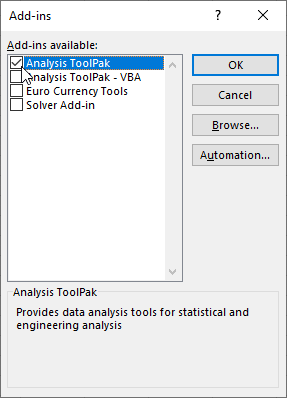Please Note: This article is written for users of the following Microsoft Excel versions: 2007, 2010, 2013, 2016, 2019, and 2021. If you are using an earlier version (Excel 2003 or earlier), this tip may not work for you. For a version of this tip written specifically for earlier versions of Excel, click here: Using Custom Add-Ins.
Written by Allen Wyatt (last updated January 30, 2025)
This tip applies to Excel 2007, 2010, 2013, 2016, 2019, and 2021
After you have created your own add-in, you can use it in your system. Once the add-in has been loaded, the functions or features in the add-in become available to any other workbook you may have open, or any time you are using Excel. All you need to do to use your add-in is follow these steps:

Figure 1. The Add-Ins dialog box.
Note:
ExcelTips is your source for cost-effective Microsoft Excel training. This tip (8529) applies to Microsoft Excel 2007, 2010, 2013, 2016, 2019, and 2021. You can find a version of this tip for the older menu interface of Excel here: Using Custom Add-Ins.

Create Custom Apps with VBA! Discover how to extend the capabilities of Office 365 applications with VBA programming. Written in clear terms and understandable language, the book includes systematic tutorials and contains both intermediate and advanced content for experienced VB developers. Designed to be comprehensive, the book addresses not just one Office application, but the entire Office suite. Check out Mastering VBA for Microsoft Office 365 today!
The standard way to customize Excel is to add tools to the Quick Access Toolbar. The program provides only a limited ...
Discover MoreThe Analysis ToolPak is used to add some very handy capabilities to Excel. If you don't have it installed, and you can't ...
Discover MoreThe auditing tools provided in Excel can provide some very helpful information about how your formulas and data are ...
Discover MoreFREE SERVICE: Get tips like this every week in ExcelTips, a free productivity newsletter. Enter your address and click "Subscribe."
There are currently no comments for this tip. (Be the first to leave your comment—just use the simple form above!)
Got a version of Excel that uses the ribbon interface (Excel 2007 or later)? This site is for you! If you use an earlier version of Excel, visit our ExcelTips site focusing on the menu interface.
FREE SERVICE: Get tips like this every week in ExcelTips, a free productivity newsletter. Enter your address and click "Subscribe."
Copyright © 2025 Sharon Parq Associates, Inc.
Comments